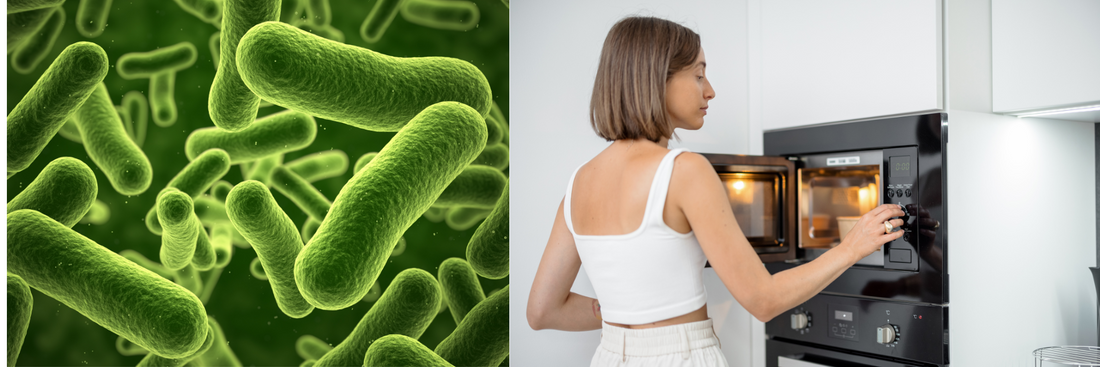Microwaves have become a staple in most households, offering a fast and convenient way to heat food. But when it comes to food safety, many still wonder: Can microwaves kill bacteria, germs, or viruses? Is reheating really effective against pathogens like Salmonella or E. coli?
In this article, we’ll explore the science behind microwave heating, the truth about its disinfection abilities, and practical tips to keep your food safe.
-
What Can You Microwave and What to Avoid? Microwave-safe Materials List
-
Can You Microwave Napkins? A Complete Guide to Avoiding Fire Hazards
Can a Microwave Effectively Kill Harmful Bacteria?

The short answer is: Yes, but only under the right conditions.
Microwaves heat food using non-ionizing electromagnetic radiation, which excites water molecules and generates heat. This heat, not the radiation itself, is what kills bacteria. To effectively kill pathogens like Salmonella, Listeria, or E. coli, the internal temperature of food must reach at least 74°C (165°F).
However, the challenge lies in uneven heating, which creates “cold spots” where bacteria can survive. This is why microwaved food must be stirred, covered, and heated thoroughly to ensure safety.
How Long to Microwave to Kill Bacteria?

There’s no one-size-fits-all answer, as cooking time depends on:
- Microwave wattage (commonly 800–1200W)
- Type and density of food
- Container used
- Stirring and placement
As a general guide:
- Reheating cooked leftovers: 1–2 minutes at full power (ensure internal temp ≥ 74°C)
- Heating raw meat: Use a food thermometer and rotate meat halfway
Does a Microwave Disinfect or Just Heat?
Microwaves don’t “sterilize” like UV or chemical disinfectants. Instead, they heat food, which indirectly kills bacteria if sufficient temperature is reached. That’s why microwaving dirty sponges, for example, can kill most surface bacteria, but not necessarily all resistant spores.
So yes, microwaves can kill germs, but only by heating the object to a bacteria-killing temperature.
Is 30 Seconds Enough to Eliminate Germs in a Microwave?
Usually not. In most cases, 30 seconds is not long enough for food to reach the 74°C threshold required to kill bacteria. Especially with dense or cold food, that short duration only warms the outer layer, leaving the inside undercooked.
To be safe:
- Use minimum 1–2 minutes, depending on food type
- Stir halfway through to eliminate cold spots
- Let food stand after heating (residual heat helps)
How Effective Is Microwaving at Killing Salmonella?

Salmonella is a common cause of foodborne illness, often found in poultry, eggs, and undercooked meat. To kill Salmonella, food must reach 74°C (165°F) throughout.
Microwaves can achieve this, but only if the food is evenly heated. Microwave-safe lids or wraps can trap steam and improve even heating, enhancing safety.
What Temperature Kills E. coli in a Microwave?
Like Salmonella, E. coli O157:H7 is destroyed at temperatures around 71°C (160°F). Again, microwaving will only kill this bacteria if that temperature is uniformly reached. Use a food thermometer if in doubt, especially when reheating ground beef, vegetables, or leftovers.
Can Microwaving Deactivate Common Viruses?
Most viruses are not heat-resistant, and studies show that microwave-heated steam or temperatures above 85°C can deactivate viruses like Norovirus or Influenza on surfaces or in food.
However, microwaving is not a guaranteed disinfection method for viruses on non-food surfaces. Use certified disinfectants instead.
Temperature Chart: Killing Bacteria in Microwaves
| Pathogen | Minimum Kill Temperature | Microwave Time (1000W) |
|---|---|---|
| Salmonella | ≥ 74°C (165°F) | 1–2 minutes |
| E. coli | ≥ 71°C (160°F) | 1–1.5 minutes |
| Listeria | ≥ 74°C | 1.5–2 minutes |
| Campylobacter | ≥ 74°C | 1.5–2 minutes |
| Norovirus | ≥ 85°C | 2 minutes or more |
| General bacteria | ≥ 60°C |
30 seconds – 2 minutes |
Note: Use a food thermometer to ensure proper internal temperature.
Does Reheating Food Kill Salmonella or Other Pathogens?

Yes, reheating food in a microwave can kill most harmful bacteria, if the food reaches the required temperature. But be careful: food stored improperly or left out too long can already have dangerous toxin buildup, which reheating won't remove.
Tips:
- Refrigerate leftovers within 2 hours
- Reheat to 74°C or higher
- Avoid reheating more than once
Frequently Asked Questions (FAQs)
Q1. Can microwaving kill bacteria in leftovers?
Yes, if the food is heated evenly to 74°C or more.
Q2. Is it safe to microwave raw meat to kill germs?
Yes, but use a thermometer to ensure proper internal temperature.
Q3. Can microwaving kill mold on food?
No. Mold spores may survive. Do not eat moldy food, even if reheated.
Q4. What container should I use to microwave food safely?
Use “microwave-safe” labeled glass or BPA-free plastic containers.
Q5. Does reheating rice in a microwave remove bacteria?
Not always. Bacillus cereus can survive; store and reheat rice carefully.
Conclusion
Yes, microwaves can kill bacteria and germs but only if food is heated properly. Simply blasting leftovers for 30 seconds won’t cut it. Use a thermometer, stir food, and allow resting time to ensure thorough heating.
Microwaves are not inherently unsafe but uneven heating is a risk. Combine your microwave with safe storage practices and proper reheating, and it remains an efficient, reliable kitchen tool.




